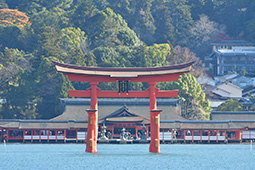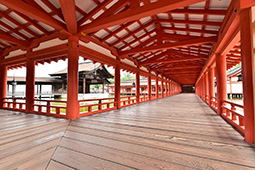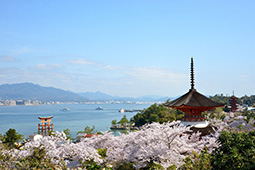April 2023
- English
- 日本語
Itsukushima Shrine: Standing Between Mountain and Sea

Otorii Gate repairs were completed in December 2022 
The Gohonsha (main hall) of Itsukushima Shrine

The Otorii Gate and the Gohonsha behind it 
One of the corridors leading to the Gohonsha 
Overlooking the Otorii Gate, the Tahoto (right, two-storied pagoda) of Itsukushima Shrine surrounded by cherry blossoms (As of March 2023, the Tahoto is presently surrounded by scaffolding for reroofing.)

Itsukushima Shrine in Hatsukaichi City, Hiroshima Prefecture, is known around the world for its striking contrasts in color and form between mountains, sea and architecture.

Itsukushima Shrine, which was registered as a World Heritage Site in 1996, is situated on the island of Itsukushima in Hatsukaichi City, Hiroshima Prefecture. Itsukushima, also commonly referred to (and hereinafter) as Miyajima, is an oval island with a circumference of about 30 kilometers in Hiroshima Bay in the western part of the Seto Inland Sea, a 10-minute ferry ride from the mainland*.
Miyajima, which is covered by dense forest and a mountain range with the 535-meter-high Mt. Misen as its highest peak, has been an object of nature worship since ancient times.

It is said that Itsukushima Shrine was built on the current site in 593 by Saeki no Kuramoto, the island’s ruler, against the backdrop of Mt. Misen and overlooking the Seto Inland Sea. About 600 years later, in 1168, the warlord Taira no Kiyomori (1118–1181), immensely powerful at the time, transformed it into a magnificent shrine complex that incorporated shindenzukuri,** an architectural style typical of aristocratic residences in the Heian period (late 8th century to late 12th century). After that, Itsukushima Shrine was repeatedly rebuilt and new buildings were added, but the shindenzukuri style has remained to the present. In this way, Itsukushima Shrine is unparalleled in Japan as a shrine in the shindenzukuri style that extends from shore to sea. As such, the central building of the shrine, the Gohonsha, along with the East Corridor and West Corridor that extend a total of about 260 meters, and other buildings are designated as national treasures.

Itsukushima Shrine even has a shrine building built in the sea, and at low tide, when the seabed is exposed, the foundations that support the shrine are exposed. In contrast, at high tide, the sea level rises nearly to the floor of the shrine building, creating the appearance that it is floating on the sea. Because it is located in the sea, the shrine building is vulnerable to natural disasters such as high waves and storm surges, so measures have been taken to reduce such damage. For example, there are gaps between the planks of the corridor floorboards, so that seawater coming up from below can overflow, which works to weaken the pressure of water against the floor.

Moreover, the precious buildings in the sacred areas of Itsukushima Shrine are constantly being maintained and restored so that they can continue to be preserved in the future. The Otorii*** Gate, which is located in the sea about 160 meters from the Gohonsha, has just completed a three-and-a-half-year repair project in December 2022. The Otorii Gate is one of the largest wooden torii gates in Japan, standing 16 meters tall and 24 meters wide. The current torii gate was rebuilt in 1875 and is the ninth to stand on the site. At low tide, it’s possible to walk right up to it.
The scenery of Miyajima, with its beautiful harmony of vermilion torii gate and shrine buildings, green mountains, and blue sea, is sure to be protected and enjoyed for many more generations to come.
* Miyajima-guchi near the ferry terminal is about 30 minutes from Hiroshima Station on the JR Sanyo Main Line and about 75 minutes by the tram that passes through downtown Hiroshima.
** The shindenzukuri primarily consists of the central building “Shinden” facing the garden on the south side, and the ancillary buildings “Taiya” on the east, west, and north sides of the Shinden.
*** A torii is the open gate that marks the perimeter and entry point of a shrine’s grounds. “O” means “big” so “Otorii” means “big gate.”

